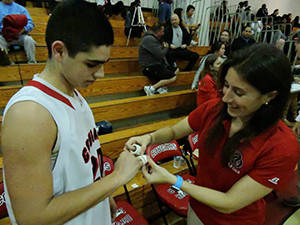
Northwest High School boys’ basketball coach Robert Smith is perfectly capable of wrapping his players’ ankles. But thanks to Montgomery County’s now full-fledged athletic training program, he no longer has to and can focus his attention solely on coaching responsibilities.
“(Coaches) are all pretty knowledgeable, but having someone who trained in the field is invaluable,” Smith said. “Especially when you’re coaching and you have nine million things going on. (A few years back) we were wrapping ankles and doing stuff and we’re certified but they probably do it a lot better than I can.”
After the success of a pilot program launched last year that placed certified athletic trainers at all 25 county public schools, MCPS signed a three-year contract with four local vendors—Adventist HealthCare Physical Health & Rehabilitation, MedStar Health, Pivot Physical Therapy and Maryland Orthopaedic Specialists—that indicates its inclusion in the fiscal budget at least through 2018. MCPS is paying the vendors $20,000 a year per school, Athletics Specialist Jeff Sullivan said, for a total of $500,000.
All MCPS coaches must obtain a variety of certifications and are required to take several continuing education courses, including the Maryland State Department of Education’s “Care and Prevention of Athletic Injuries” and the National Federation of State High School’s “Concussion in Sports – What You Need to Know,” among others.
But while coaches are knowledgeable and certainly invested in the safety of their student-athletes, they are not trained professionals. And this program takes the onus off coaches to make medical decisions.
“First of all, the schools themselves don’t really have a way of taking care of students after school, with the exception of the coach. Most injuries occur in practice, not in games,” Quince Orchard’s athletic trainer Laura Hartman said. “(Making medical decisions) is not their primary job. They’re there to coach kids and not to take care of emergencies as far as athletic injuries. There can be a lot of problems with that, in terms of conflict of interest, communication and kids falling through the cracks.”
Per the Athletic Trainer Scope of Services posted on the MCPS website, athletic trainers should be on campus for an average of 20-30 hours per week during each of the three sports seasons—approximately 42 weeks beginning in early August through the end of May. That time includes coverage for practices, scrimmages, regular season events and playoff games on site. Athletic trainers are required to be on campus whenever there is a home game or match in any sport.
“If a home tennis match was the only event, the trainer would be there at that home tennis match,” Sullivan said. “We want that equitable treatment.”
When there is more than one team playing, the trainer’s location is known to all coaches. But athletic trainers aren’t just on site in case of emergency. Their weekly schedules, coordinated with their school’s athletic director, are not limited to on-field diagnoses. They also help athletes through the rehabilitation process, pre-game and post-game treatment, such as ankle taping and icing, among other services.
“You go to the training room and it’s a revolving door of kids coming in and out for different reasons and it’s great to see,” Sullivan said. “(MCPS Director of Systemwide Athletics) Duke (Beattie) and I have gone out and visited with trainers and ADs (athletic directors) and this is exactly what we were hoping this program would be.”
Hartman said it is important to have a constant loop of communication to keep everyone on the same page. She is in touch with parents by phone and email, she said, to ensure her student-athletes keep to their recovery schedules and treatments.
There is an education component as well; athletic trainers are able to provide tips and exercises specific to each athlete and sport to try and help prevent re-injury.
In addition, all of the county’s athletic trainers work under the supervision of a physician, Sullivan said, which can help provide athletes with a direct line to doctors.
“That is absolutely a benefit,” Sullivan said. “It’s a huge advantage for kids. We do not require them to use our vendors, but they are available for kids and that’s been something useful, especially in time-sensitive areas.”
Sullivan said he’s also been pleased with the trusting and supportive relationships the athletic trainers have cultivated with their student-athletes.
There is a psychological aspect to athletic training, Hartman said. If athletes do not trust their athletic trainers, they might be less than honest. That’s why Hartman said she believes in full disclosure to athletes and walking them through the entire process of returning to play.
“Northwest volleyball won the state title and their trainer (Lauren Lyons) was there at the semifinals and there again at the championship match even though she didn’t need to be,” Sullivan said. “(The Maryland Public Secondary Schools Athletic Association) said they were providing training services so there was no need to bring anyone but Lauren has a great relationship with the kids so she followed them all the way through the finals. I saw that a lot (during the postseason), where teams were playing on the road and their trainer was following the team. They didn’t have to but the relationship they have with the kids is evident and they want to be part of the success with the team.”
ORIGINAL ARTICLE:
http://towncourier.com/athletes-coaches-benefit-from-countys-athletic-training-program/
